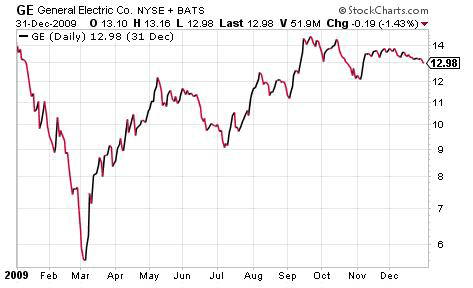Can You Predict The Death Of A Dividend Aristocrat?
James Bond knew that “Diamonds Are Forever.”
And the Dividend Aristocrats can easily be as valuable to investors as diamonds. But unlike diamonds, they are definitely not forever.
To be an Aristocrat, a stock has to pay a growing dividend for 25 years in a row.
So how does today’s S&P 500 Dividend Aristocrat become tomorrow’s dog?
Simple. All it takes is a dividend cut.
But can you see this coming? Is there a way you can feel fairly certain that a dividend cut is in the cards?
There are two telltale clues. One definitely exists in the present, and the other may unfold in the future.
These clues are making risky bets and the failure to innovate.
Let’s look at two former Aristocrats, stocks cut from the list because they signed their own death warrant by cutting their dividends. Let’s look at why these companies got in trouble and wound up as Dividend Aristocrats in exile.
Dividend Aristocrat In Exile #1: The Stink Of The Link
Century Link (CTL) was unceremoniously tossed off the list of Dividend Aristocrats after skidding in 2012.
Century Link failed to innovate. When the landline telephone business went away, so did its profits.
In the year 2000, there were 186 million phone lines in the U.S. Since then, more than 100 million copper lines have been disconnected.
That’s a tough tide for even the best-run company to swim against, and Century Link didn’t have a chance.
How has this child of U.S. West and Qwest been behaving since? Is Century Link starting to make sense once again for dividend investors?
Not really.
The company isn’t making money, it has a dangerously high Dividend Payout Ratio (82.1%), and it’s flat out struggling… struggling to transform from an old-fashioned phone company into a technology business.
It is in a brutally competitive business environment, cloud hosting. And it’s not doing very good job forecasting its financial performance.
For example, in a Q2 earnings call, R. Stewart Ewing, Jr. Executive Vice President, Chief Financial Officer and Assistant Secretary, told analysts…
“We continue to expect our dividend payout ratio for full year 2014 to be approximately 45%.”
In November, that ratio was a dangerous 81.8%.
Century Link is a prime example of how the times can pass a company by.
Look at what happened to the railroads.
They were dividend stock darlings through the 1950s. Then, in 1968, two huge railroads merged, the Pennsylvania Railroad and the New York Central.
Two years later, Penn Central filed for bankruptcy.
Look at today’s Dividend Aristocrats and you’ll see companies that have done a fine job keeping up with the times. 3M has been an Aristocrat for 55 years. Its business has changed… it started off in mining, moved into sandpaper, and now it produces more than 55,000 products.
How can you tell if a company is in danger of becoming irrelevant?
One good benchmark is to look at how much it’s investing in research and development. Another is to see if the organization is getting into new kinds of businesses.
You can find the R&D investments on the company’s balance sheet, and you can look for new business ventures in annual reports and news releases.
But sometimes the growing irrelevance of a company stares you straight in the face.
When Apple’s (AAPL) iPhone clobbered the BlackBerry (BBRY), the irrelevance was evident and instant.
Other times, troubles could be lurking in the shadows.
For Century Link, which failed to reinvent itself, we saw the exile of an S&P 500 Dividend Aristocrat triggered by the inability to innovate.
The company just wasn’t able to prepare itself for the future.
But what about companies that can’t handle the present?
Dividend Aristocrat In Exile #2: A Risky Bet Turned Off The Lights
You can’t find a former S&P 500 Dividend Aristocrat that stung dividend investors like General Electric (GE) did.
Remember what happened back in 2009?
GE got in over its head. When the economic crisis hit, it slashed its quarterly dividend from $0.31 to $0.10. GE was tossed off the Dividend Aristocrat list.
(Since the debacle of 2009, GE is back to increasing dividends. But what was once a $0.31 quarterly dividend is now $0.22.)
But that 2009 cut… what a shocker, and five years later, GE investors are still sore.
GE started paying dividends in 1899. It hadn’t made a dividend cut since 1938.
Could you have seen the storm brewing? It would have been tough.
You would have had to know that GE was basically robbing Peter to pay Paul.
Here’s what happened… To keep earnings strong, it was propping up softness in its best known businesses, like aircraft engines to medical imaging systems, by putting its hands in a hidden cookie jar.
This cookie jar was the company’s enormous financial services division, GE Capital.
Basically, GE Capital is like a bank. And just like a lot of banks in 2008, it wound up in trouble because of the bad loans it made.
Before the bad loan trouble hit, GE could move income by selling off assets from GE Capital to cover any shortfalls from other business divisions. This was how it could hit quarterly earnings targets.
If medical imaging systems sales were soft, it just sold off some GE Capital assets.
But when the financial storm of 2008 hit, and buyers for these assets dried up, GE’s risky bet couldn’t pay off any more.
It is not easy for an investor to know this sort of thing is happening.
For one thing, CEOs don’t always shoot straight.
On February 5th, 2009, GE CEO Jeffrey Immelt said, “We’ve got the cash flow to pay the dividend.”
Three weeks later, the dividend was slashed. Look at what happened to GE in 2009…

Interesting, isn’t it? After the shock of the dividend cut, GE rebounded and actually finished the year on a positive note.
Don’t bet on this happening all the time. Look at what happened to CenturyLink in 2013…

Do You See Any S&P 500 Dividend Aristocrats Dying?
Ask the tough questions. Look at a company and see how well it is adjusting to changing times. And don’t assume that the products it manufactures today are the products the world’s consumers will still be in love with tomorrow.
Dig into the financial reports to try and find a weak division that’s being propped up by a stronger division and learn what management is doing about it.
Is the fundamental problem of the weak unit being addressed, or is it being glossed over?
Keep an eye on the free cash flow and the ability of the company to keep paying growing dividends. Watch the trends of the dividend payout ratio.
And above all, don‘t take anything for granted.
Aristocrats are usually terrific stocks for dividend investors.
But they’re definitely not eternal.
Century Link Inc. (CTL)
Dividend Yield: 5.42%
Annual Payout: $2.16
Payout Ratio: 81.8%
General Electric (GE)
Dividend Yield: 3.32%
Annual Payout: $0.88
Payout Ratio: 52.7%
Category: Dividend Basics





